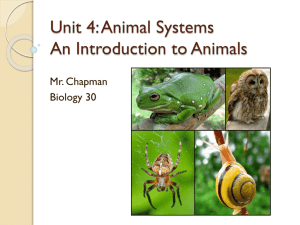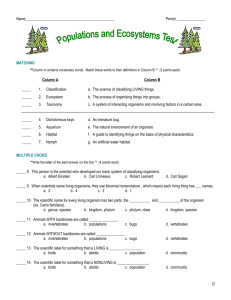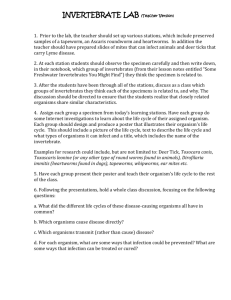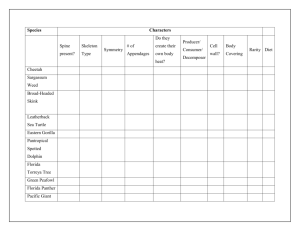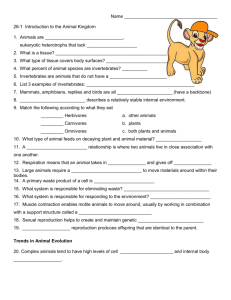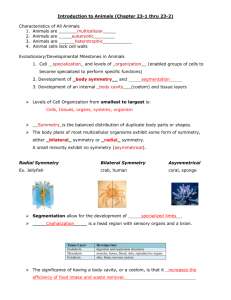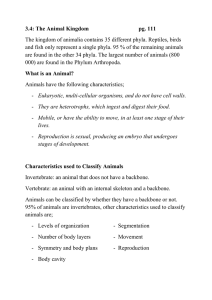Life Science Study Guide Unit Assessment Three – Invertebrates
advertisement
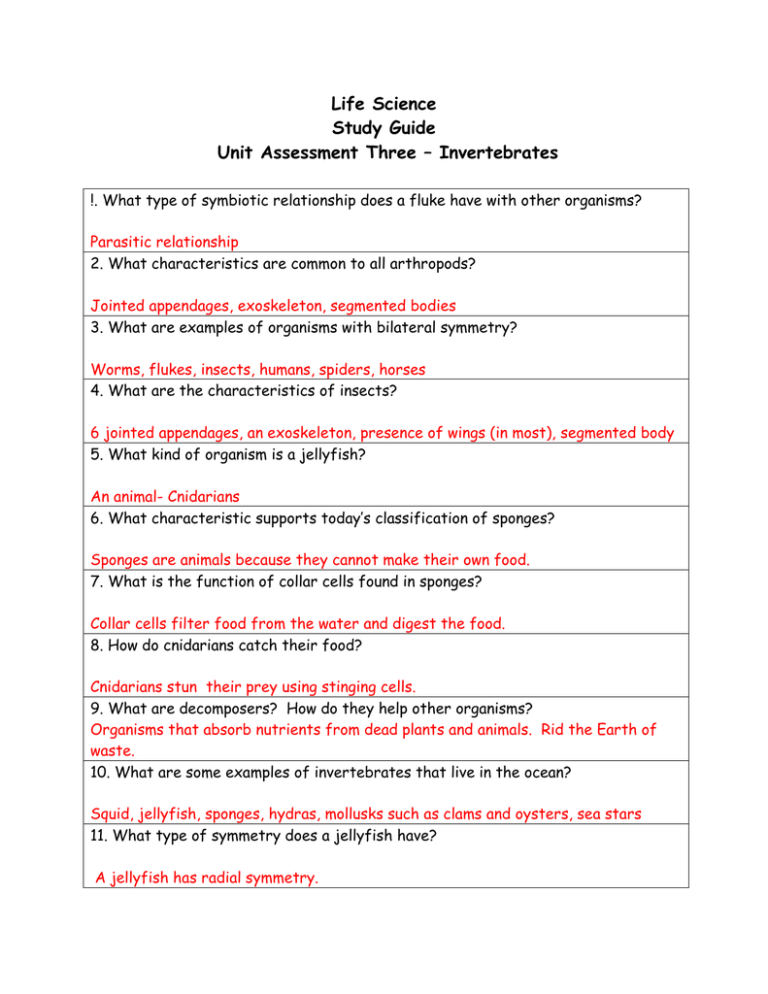
Life Science Study Guide Unit Assessment Three – Invertebrates !. What type of symbiotic relationship does a fluke have with other organisms? Parasitic relationship 2. What characteristics are common to all arthropods? Jointed appendages, exoskeleton, segmented bodies 3. What are examples of organisms with bilateral symmetry? Worms, flukes, insects, humans, spiders, horses 4. What are the characteristics of insects? 6 jointed appendages, an exoskeleton, presence of wings (in most), segmented body 5. What kind of organism is a jellyfish? An animal- Cnidarians 6. What characteristic supports today’s classification of sponges? Sponges are animals because they cannot make their own food. 7. What is the function of collar cells found in sponges? Collar cells filter food from the water and digest the food. 8. How do cnidarians catch their food? Cnidarians stun their prey using stinging cells. 9. What are decomposers? How do they help other organisms? Organisms that absorb nutrients from dead plants and animals. Rid the Earth of waste. 10. What are some examples of invertebrates that live in the ocean? Squid, jellyfish, sponges, hydras, mollusks such as clams and oysters, sea stars 11. What type of symmetry does a jellyfish have? A jellyfish has radial symmetry. 12. How many layers of tissues do worms (flatworms and roundworms) have? Worms are made up of three layers of tissues. 13. What are the characteristics of arachnids? 8 jointed appendages, segmented body made of 2 parts 14. What percentage of all animal species are invertebrates? 97% of all animal species are invertebrates 15. What type of symmetry do roundworms and flatworms have? Roundworms and flatworms have bilateral symmetry. 16. When an arthropod molts, what does it shed? An arthropod sheds its exoskeleton as it grows. 17. What are the four stages of complete metamorphosis? Egg, larva, pupa, and adult are the four stages 18. What animals belong to the phylum Mollusca? Bivalves, gastropods, cephalopods 19. What is the primary purpose of a giraffe’s long neck? The giraffe’s long neck helps it gather food in the tall trees. 20. What are four animals that belong to the phylum Cnidaria? Corals, hydras, jellyfish, sea anemones 21. How many legs does an arachnid have? Eight jointed appendages 22. Animals that molt their exoskeleton belong to what phylum? Arthropoda 23. What invertebrates belong to the phylum Porifera? Sponges 24. How many stages are there in complete metamorphosis? Four – egg, larva, pupa, adult 25. What are examples of echinoderms? Sea star, sand dollar, sea urchin 26. Which kingdoms consist of multicellular organisms? Plants, Animals, and Fungi 27. What are the stages of incomplete metamorphosis? Three – egg, nymph and adult 28. What adaptations protect animals from predators? Camouflage, mimicry, outer coverings, speed, size 29. What type of symmetry do both jellyfish and sea stars have? Jellyfish and sea stars have radial symmetry 30. In our classification system, which group has the most organisms with the fewest characteristics in common? Kingdom 31. What does camouflage help an organism do? Camouflage hides an organism from its predators. 32. What are the characteristics of the animal kingdom? Multicellular organism with no cell wall and capable of movement 33. The organisms of which kingdom have adaptations for finding, capturing, eating and digesting food? The Animal Kingdom 34. On a dichotomous key, what characteristic would separate an earthworm and a maple tree into different kingdoms? The presence of a cell wall 35. What characteristic do scientists consider first when classifying an organism into a kingdom? How an organism develops
